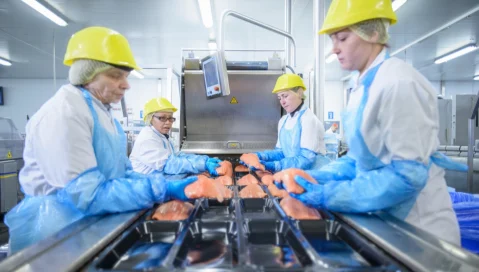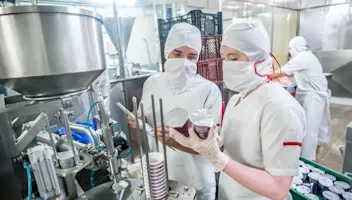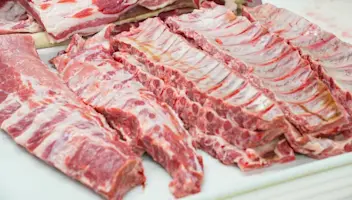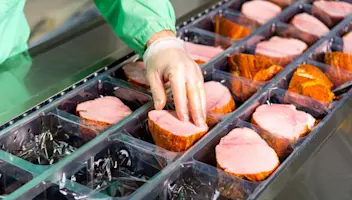Meat Industry Regulations: What You Need to Know, and How ERP Helps You Stay Compliant
Meat Industry Regulations: What You Need to Know, and How ERP Helps You Stay Compliant
Meat Industry Regulations: What You Need to Know, and How ERP Helps You Stay Compliant
6 Dez 2023
John McCurdy
From calls for greater sustainability and better animal welfare to the rise of plant-based alternatives and lab-cultivated products, the global meat industry faces challenges that demand attention. Of course, these are just some of the most recent developments, and meanwhile another that dates back to before the Industrial Revolution looms large—government regulations.
There are many national bodies that establish their own distinct standards and prescribe enforcement in their jurisdiction, but with food safety an imperative around the world, many are becoming more exacting and demanding in their specifications and expectations.
And with the consequences for violations ranging from fines and suspension of business to prison sentences—not to mention negative press and damage to brand reputation—companies must do their due diligence and establish clear procedures to meet all requirements.
That means you need a sound understanding of the regulations that apply to your organization and its products, as well as a platform with which to apply that knowledge and help ensure compliance. The ideal system would be industry-specific enterprise resource planning (ERP) software that comes complete with functionalities tailored for your operation’s highly specialized processes.
Read on to get the skinny on the meat industry safety regulations in the U.S., UK and the European Union (EU), as well as the key features of advanced meat ERP solutions that facilitate compliance.
Meat Industry Regulations by Region
Take note that the regulations for each region apply not only to businesses that are physically located in those regions, but also foreign organizations that import goods to market them in the given region. The specifics on enforcement, including inspections, warnings, litigation, fine amounts, sentence limits and more vary—but as mentioned before, it’s best to approach adherence to food standards proactively.
United States
In the U.S., meat and meat products are regulated jointly by the U.S. Food and Drug Administration (FDA) and United States Department of Agriculture (USDA). As a result, the FDA’s Food Safety Modernization Act (FSMA) of 2011; previous or supplementary acts that apply; and the Federal Inspection Requirements for Meat Products are all relevant and require compliance.
The USDA Food Safety and Inspection Service has primary responsibility for enforcement for the products named in the Federal Meat Inspection Act and Poultry Products Inspection Act, which includes products made with “amenable species” such as cattle, sheep, swine, goats, domestic poultry (chickens, turkeys, ducks, geese and guinea), ratites and squab.
Meanwhile, the FDA regulates game meat and game meat products, which are those made from “non-amenable” animals, including antelope, bison, deer, elk, reindeer, muskrat, non-aquatic reptiles, opossum, rabbit, raccoon, squirrel, water buffalo and wild fowl.
In terms of seafood, the FDA takes primary responsibility for all but one variety—catfish, which falls under the purview of the USDA. The FDA’s guidance based on the pertinent regulations is updated regularly and maintained online.
Finally, it’s worth mentioning that the country of origin (COOL) law for beef and pork was repealed in 2015, but equivalent regulations for poultry products, seafood and many other kinds of meat still apply. Of late, there has been a push to reimplement COOL requirements for beef given the importance of traceability globally.
United Kingdom
The Food Standards Agency (FSA) regulates the food and beverage industries of England, Wales and Northern Ireland. The most recent major act, the Food Standards Act of 1999, established the FSA and its responsibility to manage and enforce regulations. Following Brexit, the body of laws is composed of both the UK’s own food legislation and some retained from the EU.
The FSA maintains and updates the legal requirements specifically for meat and poultry establishments, including stipulations for food hygiene, processing facility sanitation, equipment, slaughterhouses and more. There is also separate guidance for fish and shellfish processors.
As of 2015, Food Standards Scotland (FSS) has regulated that country’s market. The major legislation is a combination of the Scottish government’s laws and retained UK and EU regulations. The agency has also published some advice specific to meat, poultry and game processors, as well as fish processors.
European Union
The basis for food and beverage regulations in the EU is the European Parliament and Council’s General Food Law, Regulation (EC) No. 178/2002. It includes general principles, requirements and procedures that promote food safety from farm to fork, as well as provisions that led to the establishment of the European Food Safety Authority (EFSA) for independent scientific advice and the Rapid Alert System for Food and Feed (RASFF) for management of emergencies and crises.
The EU also provides more specific standards and requirements for the various subverticals within the broader meat market, including the beef, pork, poultry, lamb and goat sectors, as part of its common agricultural policy. One of the more notable updates of late was the issuance of the EU Poultry Directive, which aims to improve animal welfare where chickens are kept for meat production.
Specifically for processors of beef, pork and other related products, the Union of Producers and Employers of Meat Industry (UPEMI) currently publishes additional guidance and standards through the “Meat With European Quality” campaign. Backed by funding from the EU, the materials are mostly informative and aimed at a wide audience, but there is a pronounced focus on quality and food safety.
Regulations and standards for businesses specializing in seafood are fairly complex, but the main elements beyond the General Food Law include Regulation (EC) No. 1010/2009 (otherwise known as the EC Illegal, Unreported and Unregulated (IUU) regulation); several regulations regarding maximum residue levels in products; and the sector-specific special labeling requirements.
How an ERP for Meat Processing Supports Regulatory Compliance
With specialized features to help your business adhere to the rigorous requirements of modern regulatory systems, meat ERP software can help you cover all the bases and give you peace of mind that all aspects of your operations and products are compliant under the law.
These are just a few of the functionalities that are particularly useful for meat, poultry and seafood companies:
Product specifications and advanced attributes—Define attributes to tie to products, like the cut of pork or grade of beef, and any others that your goods require.
Quality control and inspection status—Establish standardized quality assurance processes, assign checks to personnel, specify quality triggers and maintain visibility into the status of inspections.
Non-conformances—Identify instances of non-conformance with quality and safety standards, then expedite the process of rectification via integration with shared platforms.
Labeling and packaging—Create accurate, detailed labels and barcodes for your products that include important details, such as customer name, lot number, ingredient details and more.
Producer certification—Maintain supplier certifications at every step in the supply chain down to the sublot level and preserve associated certificates with applicable products post-processing.
Compliance documents—Manage all compliance documents digitally with electronic document management (EDM) and support accessibility of critical information.
It’s also worth briefly noting that ERP software provides many additional tools for other operational areas outside of compliance, including supply chain management, inventory control, pricing and more. Advanced industry-specific ERP solutions, like Aptean Food & Beverage ERP, also have functionality to manage catch weight—which, as you know, is frequently a critical factor in the meat industry.
Software Solutions To Fortify Your Business for the Future
With all the change that the global meat industry has seen over the past several years, your company must be prepared for what’s next—if you’re not, you could fall behind the competition, which is always fierce in this market. If you’re still using manual methods to manage regulatory compliance or any of your other critical functional areas, consider implementing more robust solutions in the near future.
ERP is just one of the systems that help meat, poultry and seafood processors transform into digitally mature organizations capable of sustained growth and long-term success. Others like overall equipment effectiveness (OEE), enterprise asset management (EAM), product lifecycle management (PLM) and route optimization software are some of the other pieces of a well-rounded tech stack.
Choosing to work with a single trusted solution provider for all of your business software needs comes with significant advantages, including the opportunity to form a long-term partnership based on a commitment to mutual success. Aptean’s track record serving the food and beverage industry with leading solutions and support can be seen in our numerous customer success stories.
Learn more about Building a Business Case for Food and Beverage ERP and how the right software can help your business shore up seven major industry pain points. And feel free to contact us today with any questions.
Related Content





Sind Sie bereit für maßgeschneiderte Lösungen zur Straffung der Abläufe?
Unser ERP für Fleisch- und Meeresfrüchteverarbeiter treibt positive Veränderungen voran und dient als zukunftssichere Plattform für Wachstum.



